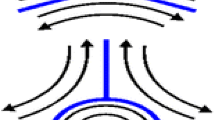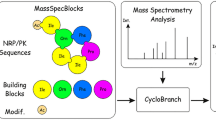Abstract
Analysis of large (>10,000 entries) databases consisting of high-resolution tandem mass spectra of peptide dications revealed with high statistical significance (P < 1⋅10–3) that peptides with non-identical first two N-terminal amino acids undergo cleavages of the second peptide bond at higher rates than repetitive sequences composed of the same amino acids (i.e., in general AB- and BA- bonds cleave more often than AA- and BB- bonds). This effect seems to depend upon the collisional energy, being stronger at lower energies. The phenomenon is likely to indicate the presence of the diketopiperazine structure for at least some b2 + ions. When consisting of two identical amino acids, these species should form through intermediates that have a symmetric geometry and, thus, must be subject to the Jahn-Teller effect that reduces the stability of such systems.

ᅟ



Similar content being viewed by others
References
Wells, J.M., McLuckey, S.A.: Collision-induced dissociation (CID) of peptides and proteins. Methods Enzymol. 402, 148–185 (2005)
Dongre, A.R., Jones, J.L., Somogyi, A., Wysocki, V.H.J.: Influence of peptide composition, gas-phase basicity, and chemical modification on fragmentation efficiency: Evidence for the mobile proton model. J. Am. Chem. Soc. 118, 8365–8374 (2006)
Harrison, A.G., Yalcin, T.: Proton mobility in protonated amino acids and peptides. Int. J. Mass Spectrom. 165, 339–347 (1997)
Hunt, D.F., Yates, J.R., Shabanowitz, J., Winston, S., Hauer, C.R.: Protein sequencing by tandem mass spectrometry. Proc. Natl. Acad. Sci. U. S. A. 83, 6233–6237 (1986)
Loo, J.A., Edmonds, C.G., Smith, R.D.: Tandem mass spectrometry of very large molecules. 2. Dissociation of multiply charged proline-containing proteins from electrospray ionization. Anal. Chem. 65, 425–438 (1993)
Yu, W., Vath, J.E., Huberty, M.C., Martin, S.A.: Identification of the facile gas-phase cleavage of the Asp-Pro and Asp-Xxx peptide bonds in matrix-assisted laser desorption time-of-flight mass spectrometry. Anal. Chem. 65, 3015–3023 (1993)
Tsaprailis, G., Nair, H., Somogyi, A., Wysocki, V.H., Zhong, W.Q., Futrell, J.H., Summerfield, S.G., Gaskell, S.J.: Influence of secondary structure on the fragmentation of protonated peptides. J. Am. Chem. Soc. 121, 5142–5154 (1999)
Burlet, O., Yang, C.Y., Gaskell, S.J.: Influence of cysteine to cysteic acid oxidation on the collision-activated decomposition of protonated peptides: Evidence for intraionic interactions. J. Am. Soc. Mass Spectrom. 3, 337–344 (1992)
Zhang, Z.Q., Bordas-Nagy, J.: Peptide conformation in gas phase probed by collision-induced dissociation and its correlation to conformation in condensed phases. J. Am. Soc. Mass Spectrom. 17, 786–794 (2006)
Harrison, A.G.: Charge-separation reactions of doubly-protonated peptides: Effect of peptide chain length. J. Am. Soc. Mass Spectrom. 20, 1890–1895 (2009)
Savitski, M.M., Kjeldsen, F., Nielsen, M.L., Garbuzynskiy, S.O., Galzitskaya, O.V., Surin, A.K., Zubarev, R.A.: Backbone carbonyl group basicities are related to gas-phase fragmentation of peptides and protein folding. Angew. Chem. Int. Ed. 46, 1481–1484 (2007)
Harrison, A.G.: Effect of the identity of Xaa on the fragmentation modes of doubly-protonated Ala-Ala-Xaa-Ala-Ala-Ala-Arg. J. Am. Soc. Mass Spectrom. 22, 906–911 (2011)
Savitski, M.M., Hith, M., Fung, Y.M.E., Adams, C.M., Zubarev, R.A.: Bifurcating fragmentation behavior of gas-phase tryptic peptide dications in collisional activation. J. Am. Soc. Mass Spectrom. 19, 1755–1763 (2008)
Yang, H., Good, D.M., van der Spoel, D., Zubarev, R.A.: Carbonyl charge solvation patterns may relate to fragmentation classes in collision-activated dissociation. J. Am. Soc. Mass Spectrom. 8, 1319–1325 (2012)
Pearson, R.G.: Concerning Jahn-Teller effects (first-order, pseudo, and second-order Jahn-Teller effects/symmetry rules). Proc. Natl. Acad. Sci. U. S. A. 72, 2104–2106 (1975)
Falth, M., Savitski, M.M., Nielsen, M.L., Kjeldsen, F., Andren, P.E., Zubarev, R.A.: SwedCAD, a database of annotated high-mass accuracy MS/MS spectra of tryptic peptides. J. Proteome Res. 6, 4063–4067 (2007)
Good, D.M., Marin-Vicente, C., Zubarev, R.A.: Are the majority of a(2)-ions cyclic? Phys. Chem. Chem. Phys. 12, 13372–13374 (2010)
McLafferty, F.W., Turecek, F.: Interpretation of Mass Spectra. University Science Books. Sausalito, CA (1993)
R Core Team: R: A Language and Environment for Statistical Computing. R Foundation for Statistical Computing, http://www.R-project.org (2013)
Fisher, R.A.: Statistical Methods for Research Workers, 4th edn. Oliver and Boyd, Edinburgh etc. Edinburgh and London: Oliver and Boyd (1932)
Jahn, H., Teller, E.: Stability of polyatomic molecules in degenerate electronic states. I. Orbital degeneracy. Proc. R. Soc. Lond. A, Math. Phys. Sci. 161, 220–235 (1937)
Wörner, H.J., Merkt, F.: Jahn-Teller effects in molecular cations studied by photoelectron spectroscopy and group theory. Angew. Chem. Int. Ed. 48, 6404–6424 (2009)
Thiemens, M.H., Heidenreich, J.E.: The mass-independent fractionation of oxygen: A novel isotope effect and its possible cosmochemical implications. Science 219, 1073–1075 (1983)
Gao, Y.Q., Marcus, R.A.: Strange and unconventional isotope effects in ozone formation. Science 293, 259–263 (2001)
Gellene, G.I.: An explanation for symmetry-induced isotopic fractionation in ozone. Science 274, 1344–1346 (1996)
Pack, R.T., Walker, R.B.: Some symmetry-induced isotope effects in the kinetics of recombination reactions. J. Chem. Phys. 121, 800–812 (2004)
Paizs, B., Suhai, S.: Fragmentation pathways of protonated peptides. Mass Spectrom. Rev. 24, 508–548 (2005)
Acknowledgment
This work was supported by the Wallenberg Foundation and the Swedish Research Council (grants 2007–4410 and 2011–3726 to RAZ). D.M.G. is grateful for a post-doctoral fellowship from the Wenner-Gren Foundation.
Author information
Authors and Affiliations
Corresponding author
Rights and permissions
About this article
Cite this article
Good, D.M., Yang, H. & Zubarev, R.A. N-Terminal Peptide Sequence Repetition Influences the Kinetics of Backbone Fragmentation: A Manifestation of the Jahn-Teller Effect?. J. Am. Soc. Mass Spectrom. 24, 1671–1675 (2013). https://doi.org/10.1007/s13361-013-0628-7
Received:
Revised:
Accepted:
Published:
Issue Date:
DOI: https://doi.org/10.1007/s13361-013-0628-7




